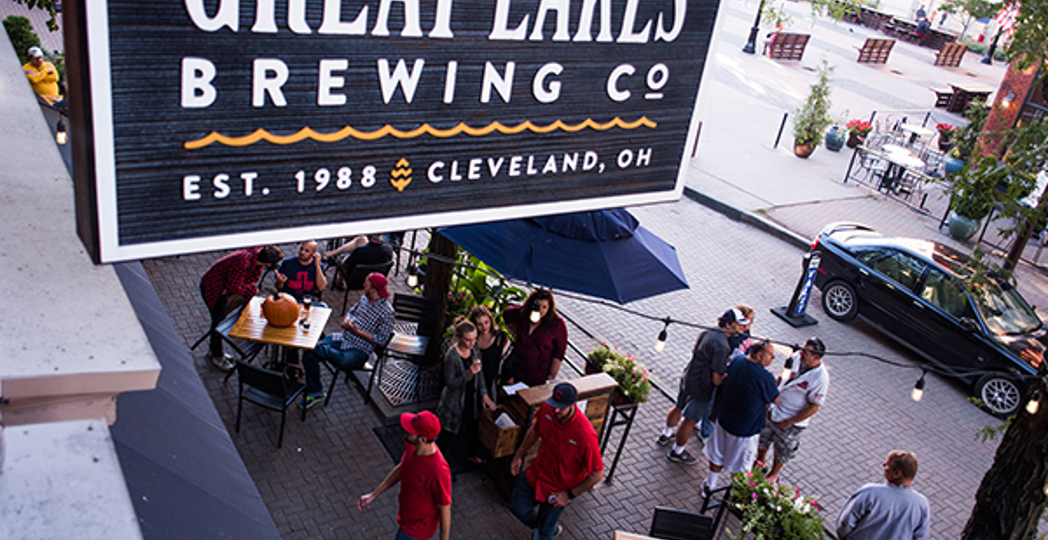Where Does Ohio's Craft Brewery Industry Stand?
by Terry Troy | Aug. 1, 2021 | 4:00 AM

When it comes to relaxing after a hard summer day’s work, there are few sights more welcoming than a tall frosty glass of beer. Whether you prefer ales, porters or stouts or are more a fan of lagers and pilsners or IPAs, you’ll find all of that and more in Northeast Ohio.
The Greater Cleveland area and other cities in the Buckeye State have become beer lover destinations, with cities like Cleveland and Cincinnati regularly breaking into social media and magazines’ top 10 beer loving destinations lists. And while the local craft brewing industry took a hit during the pandemic, especially in taprooms and restaurants, it pivoted toward new products and new ways of distribution that are sure to build a strong foundation for the craft brewing industry as a whole.
So where do we stand today?
Ohio’s craft brewing industry generated an estimated $880.7 million in economic activity in the state in 2020, in the middle of a pandemic, according to the Ohio Craft Brewers Association’s (OCBA) most recent economic impact study. At the end of 2020, there were 357 craft breweries in operation, including 47 that opened last year. An additional 77 breweries are in the planning stages.
“The most recent count, according to my new spreadsheet, is that we currently have 374 breweries in Ohio, which is quite a few more than in other states,” says Mary MacDonald, executive director of OCBA. “We’ve had about 20 open so far this year, which puts us on a pace to hit 400 by the end of the year.”
The number of craft breweries in Ohio jumped 19% in the last two years, despite the pandemic. And according to an OCBA member study, 72% of breweries intend to increase production this year.
Ohio remains an exceptionally strong place for craft brewers. The national Brewers Association Annual Production Report ranked Ohio fifth among U.S. states in craft beer production volume and sixth in economic impact among all of the states in 2019.
But the industry was hit hard by COVID-19. Nationally, U.S. craft beer sales volume declined 9% according to the Brewer’s Association, while direct jobs declined 14%.
In Ohio, state-mandated shutdowns of taprooms, bars and restaurants in early 2020, the restriction of alcohol sales after 10 p.m., stay-at-home advisories and safety concerns related to outdoor gatherings all took their toll on the industry.
“It had a two-pronged impact on our business,” says Pat Conway, who founded Great Lakes Brewing Co. in Cleveland in 1986 along with his brother Dan. “First of all, the draft business disappeared because bars and restaurants were closed. That was something that couldn’t be remedied.
“But people were also buying six packs and cases and partying at home or in their backyard. So our packaged product sales went up. We even introduced cans for the first time.”
Which was a Godsend for the company, says Conway, with the canned brews just flying off the shelf.
“We also introduced a whole array of new products this year,” he adds.
As one of the pioneers of the Ohio craft brewing industry, Great Lakes does have some legacy brands that are the envy of other craft brewers — and that buoyed the company during the pandemic.
“We have always had great legacy beer brands like our Dortmunder, Commodore Perry, Eliot Ness and Edmund Fitzgerald,” says Conway.
And, of course, there is Great Lakes’ Christmas Ale, which is tapped during the brewery’s Christmas in July celebration.
“It was one of the last events we had before we closed last year,” says Conway. “We told everyone to be safe. We took temperature readings and everyone socially distanced. A lot of the colorful lunacy surrounding it was not there, but people were still glad to get out for the afternoon. And we still had lines around the corner. But it was nowhere near the crowd we usually have.”
By staggering introductions of its legacy beers, Great Lakes is able to even out its business, Conway explains.
“We’re not the Christmas Ale Brewing Co. We are the Great Lakes Brewing Co., which is a nice problem to have,” says Conway. “So just prior to the Christmas Ale we have our Oktoberfest, which sells like it’s free, and then right after Christmas Ale there’s Conway’s Irish Ale, which is one of the greatest seasonal products that we produce.”
One problem all of the craft breweries are facing is consistency, Conway says.
“Beer is an agricultural product,” he explains. “A lot of people will ask me why the Christmas Ale tastes a little different this year. But we never change the recipe. Why change something that isn’t broken? We use real honey, real cinnamon and other natural ingredients.”
Those will naturally change in taste slightly from year to year, much in the same way a grape will change on the vine due to growing conditions.
In addition to its legacy beer brands, Great Lakes last year came out with new beer products such as the Hazecraft, Crushworthy and its Imperial IPA (India Pale Ale) Series.
“And those all came on line in cans,” says Conway. “So far in 2021, we are the top performing brewery of the Top 40 craft breweries in the U.S.”
And Great Lakes continues to add to its Imperial IPA Series this summer, with the introduction in June of Tidal Fury Imperial Hazy IPA in 16-ounce-can four packs. Of course, coming up with new brew is essential to survival in the industry — especially with many new alcoholic seltzer and other products coming online.
“Keeping up with the changing tastes of consumers is always a challenge,” Conway admits.
And Great Lakes seems to be excellent at coming up with the tastes consumers want. In June, Great Lakes was named by Talkwalker, a social media and analytics company, as one of the 32 most beloved beer brands in the world.
Taproom Troubles
On the restaurant and taproom side, it was a much different story for Great Lakes, as well as many other craft brewers across the area. Many constructed physical barriers inside taprooms and restaurants, installed advanced air filtration systems and limited seating capacity. To top it all off, there were other challenges that included a shortage of raw materials, as well as an aluminum can shortage — not to mention the current reduction in workforce availability.
While most of Ohio’s craft brew taprooms have reopened, many have done so at a reduced capacity.
“It’s strange because we are still ramping up,” says Conway. “Our restaurant is still only open part time. Thankfully, Councilman Kerry McCormick was able to vacate Market Avenue, so we were able to pick up a few extra seats outside, because everybody wants to be outside this time of year.”
But attracting back employees continues to be a problem across the industry.
“At one time, we had 250 employees in our restaurant, and that came down to about 120 through furloughs and layoffs,” Conway says. “We actually closed the restaurant for three months.”
According to the OCBA membership survey, less than 6% of brewery taprooms and restaurants are operating at full capacity, while 12% are at 76% to 99%. Almost 50% are operating at between 51% and 75% while 28% are operating at 26% to 50%. Less than 6% are operating at under 25%.
But now that the masks have come off, and social distancing being more generous, sales are picking up dramatically — and not just at Great Lakes.
HiHo is Off to Work
“We were ‘to-go’ only for five out of 12 months in 2020,” says Ali Hovan, co-founder of HiHo Brewing Co. in Cuyahoga Falls. “Pivoting from a 200-plus capacity taproom to ‘to-go’ for a total of 16 hours a week was a challenge, but the community/customer support was incredible and kept us afloat.
“Now we are up and running. We do not have as many seats as we did pre-COVID-19, but our taproom is comfortably full, and we are busy.”
Right now, supply chain issues with ingredients and the can shortage are HiHo’s biggest challenges. And safety concerns are still top of mind with many craft breweries like HiHo, “probably because sanitation plays such as important role in the production of beer,” says MacDonald.
“Over the past year-plus, we have been, first and foremost, dedicated to the continued safety of our employees and customers,” says Paul Benner, co-founder of Platform Beer Co., which sold out to Anheuser-Busch InBev a year-and-a-half ago. “As we are now transitioning to a climate with bars, restaurants and taprooms reopening, we are, more than ever, committed to creating a comfortable environment for employees and guests alike. We feel that with the summer upon us, this is a great opportunity for guests to come back out to their favorite breweries and enjoy a beer or two.”
From its humble beginnings in 2014 at a brewhouse in Cleveland, Platform expanded to a second tasting room in Columbus, a production facility in Cleveland, a Cincinnati tasting room named LOCOBA and a sour beer facility in Cleveland called Phunkenship. Today, the company distributes throughout Ohio, Indiana, Kentucky, Pennsylvania and New York City.
Named as one of the country’s fastest growing breweries of 2017 by the Brewers Association, Platform’s acquisition by Anheuser-Busch InBev made both Benner and co-founder Justin Carson millionaires. While the deal still offered the partners a great deal of autonomy to continue to control and grow their company, it did lead to some understandable consolidation in staff.
“Some people did make a lot of money, but some eventually lost their jobs,” says one source.
But for the partners, selling to Anheuser-Busch InBev was the perfect fit.
“We are about a year-and-a-half into our partnership and are very happy with the state of the brewery,” Benner says. “We continue to have the autonomy and freedom to evolve as an organization and grow in a manner that keeps our vision for the brewery at the forefront.”
Platform celebrated its seven-year anniversary on July 4.
“And we can’t wait to see what the coming years bring for our company and our team,” Benner says.
Keep on Crafting
Despite all of the challenges brought on by the pandemic, as well as some consolidation in the industry, craft brewing seems to be growing exponentially.
“One of the reasons our industry is so strong here in Ohio is that we have some very favorable laws,” says MacDonald. “The price of the license to brew beer dropped and with it they included a taproom. So as long as you are brewing your own beer that you sell on premises, you can have a taproom that goes along with the manufacturing.”
Ohio also allows self-distribution, which gives small breweries the chance to get their product out more effectively.
“Small brewers are the best salespeople for their product,” says MacDonald. “They know their brand and the beers they are producing. They are the authentic purveyors of their story. Self-distribution is huge in terms of letting them grow their markets.”
Greater Cleveland and Northeast Ohio also have a very strong brewing heritage.
“We were one of the top brewing centers in North America back in the late 19th century,” Conway explains.
Beer brewing in Cleveland has probably been around since the city’s inception, however the industry really took off in the 1840s with the arrival of German immigrants. They had a big impact on the brewing industry, which previously had been limited to ales, porters and stouts due to our area’s influence from New England as a part of the Connecticut Western Reserve. Germans brought with them lagers and pilsners, which proved to be popular with Clevelanders of all ethnic backgrounds.
One of the first popular German Brewers was Gehring Brewery, founded at what is today Gehring Avenue and West 25th in Ohio City. Other immigrants quickly jumped on the bandwagon, and soon there were 23 breweries in the city, many of them in the Ohio City neighborhood.
“Our own brewery was once the Schlather Brewing Co.,” says Conway. “The Gehring Brewery was located right where the new ten-story building is going up, while the Leisy Brewing was at Fulton Road and Vega Avenue. So what is going on in Ohio City today is actually a repeat of what was going one more than 100 years ago.
“With the pandemic, we have been through a lot of psychological and economic pain,” Conway adds. “As an industry, we were strong going in, and I think we’ll be in an even better place as we come out, especially with all of the innovation that is taking place.”
Trending
-
1
-
2
-
3
-
4
-
5










